Affiliate links on Android Authority may earn us a commission. Learn more.
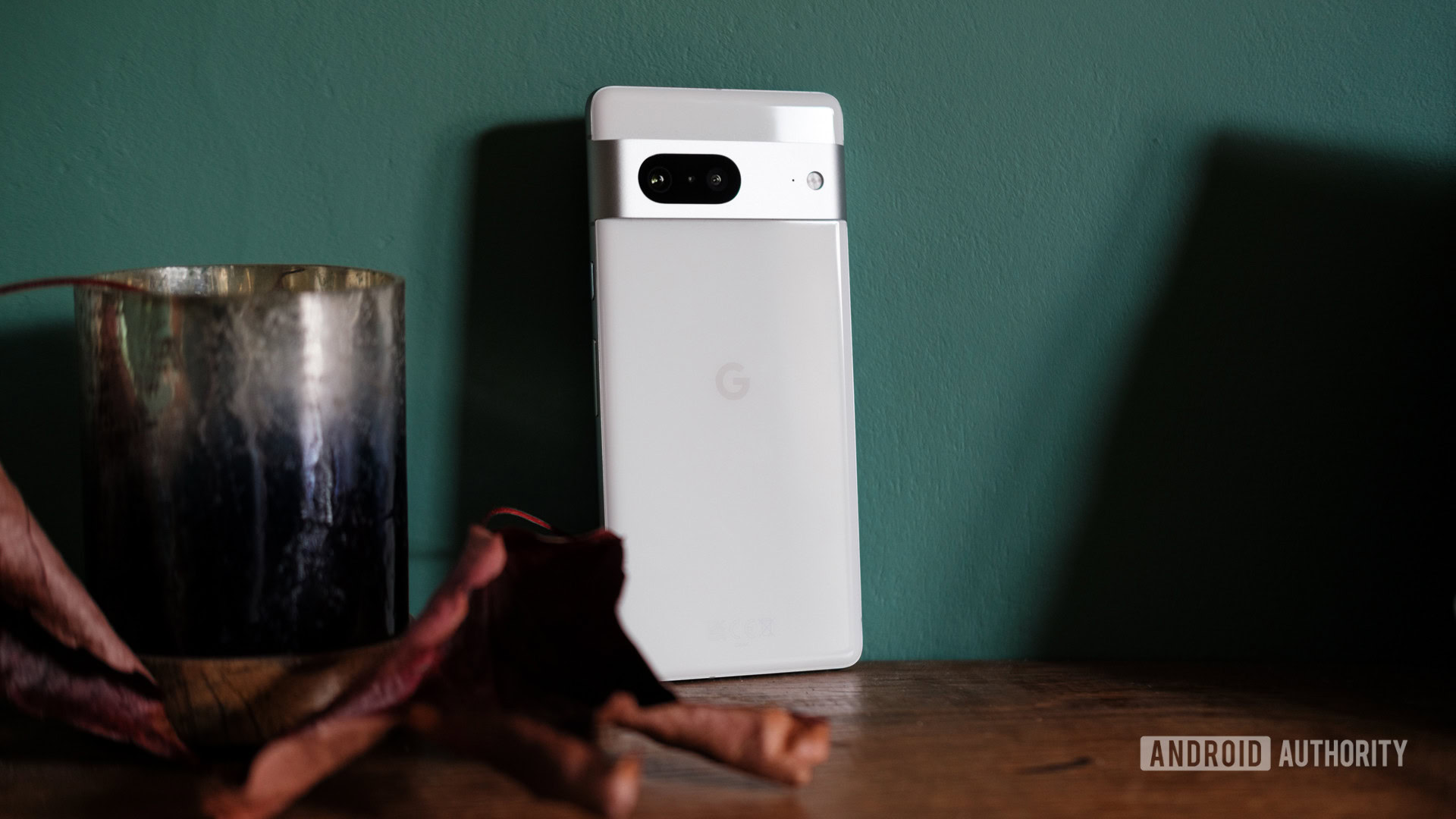


Google Pixel 7
What we like
What we don't like
Our scores

Google Pixel 7
Catering to both high-end and budget-conscious consumers is no easy task, but 2021’s Pixel 6 and Pixel 6 Pro did just that, revitalizing Google’s hit-and-miss smartphone series in the process. With the Google Pixel 7, Mountain View once again hits the sweet spot between flagship specs and experiences without breaking the bank. With a price that severely undercuts its closest rivals from Samsung and Apple, does Google make a few too many compromises, or is this the smartphone bargain of the decade? Let’s find out in Android Authority’s Google Pixel 7 review.
Update, March 2024: The latest update to this review includes details of the latest March Pixel Feature Drop.
What you need to know about the Google Pixel 7
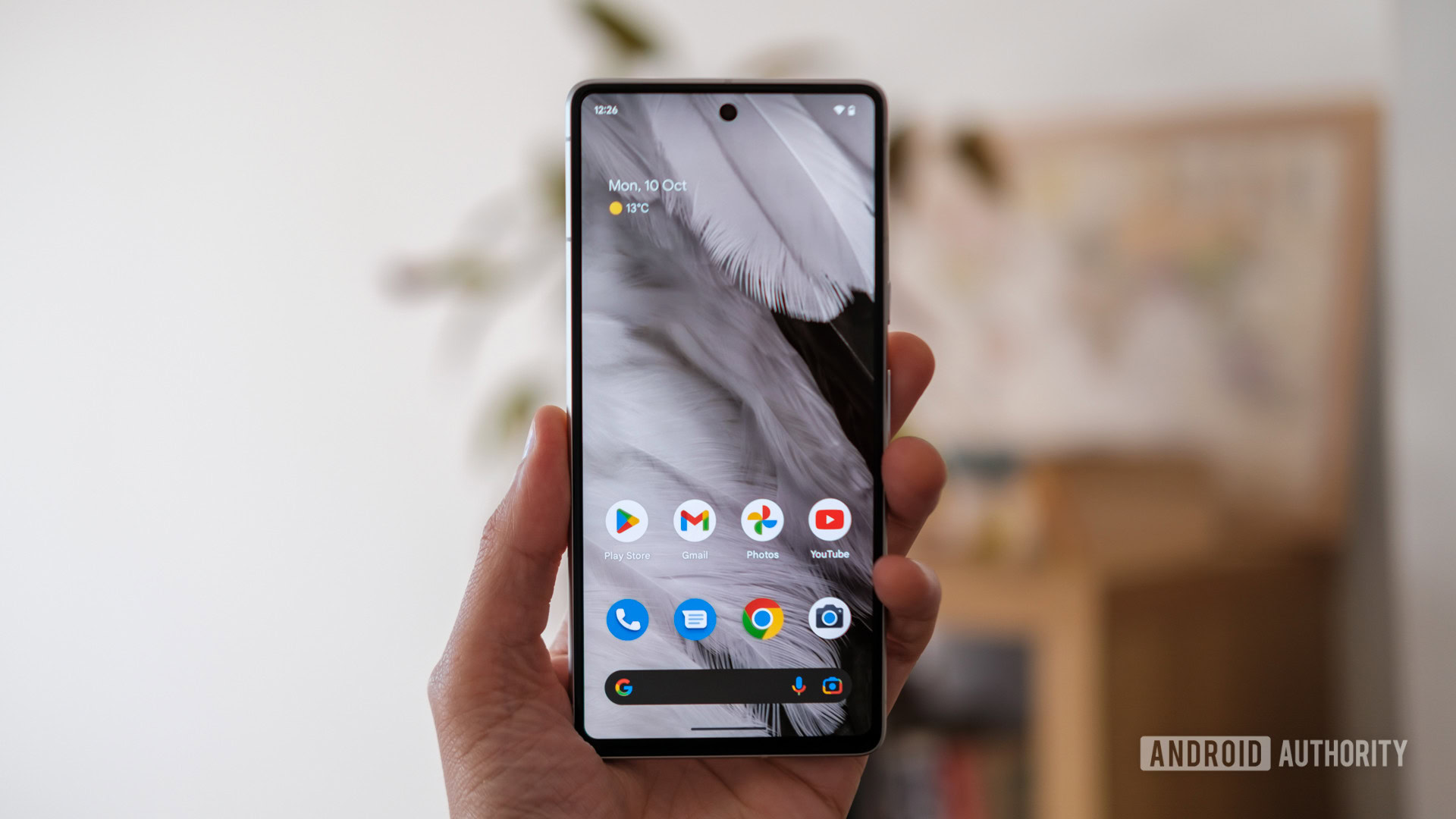
- Google Pixel 7 (8GB/128GB): $599 / £599 / €649
- Google Pixel 7 (8GB/256GB): $699 / £699 / €749
Google’s Pixel 7 can be politely thought of as building firmly on the Pixel 6 series, in so far as very little has changed aside from a slightly modified design. That’s not necessarily a bad thing though, as Google moves to refine rather than revamp a smartphone formula it’s finally found some level of success with. With the Pixel Watch and Pixel Watch 2 also in play, Google’s mobile lineup aims to cement the company as a major-league hardware player in the Android ecosystem — with the Pixel 7 the Goldilocks option for newcomers.
As the successor to 2021’s value-oriented Pixel 6 and the upgrade over the newer and cheaper Pixel 7a, the Pixel 7 boasts a price tag that screams typical upper-mid-range phone. But don’t let that deceive you. The Pixel 7 is imbued with the same machine learning Tensor G2 smarts, impressive 50MP main camera, and even the same overall design language and build quality as the brand’s more expensive Pro variant. In fact, the two phones are more alike than they are different, at least when it comes to all-important software capabilities. The exception is that the Pro continues to be the model of choice for those after Google’s best camera package, but more on that later.
You'll have seen a lot of the Pixel 7 before, but there are some new twists.
The Pixel 7 does make a few other cuts to the Pro’s formula to hit the price point, too. There’s less RAM in the regular model, down to 8GB from 12GB, but that won’t make a meaningful difference outside of extreme multitasking. The Pixel 7 comes in two memory options, 128GB and 256GB; eschewing the 512GB maximum capacity of the Pro variant. With no microSD card support either, the phone would have you rely on Google One cloud storage subscriptions should you need extra space beyond the 256GB limit. Like its predecessor, the package is housed behind a similar 6.32-inch 90Hz FHD+ display but with a higher peak brightness of 1,400 nits. The phone also features familiar 21W wired and wireless charging capabilities, a main and ultrawide rear camera partnership, and a smaller 4,355mAh battery (down from 4,614mAh on the Pixel 6).
As is par for the course these days, Google forgoes a charger in the box. You’ll have to bring your own USB Power Delivery PPS-compatible plug if you want peak charging power. However, it does include a USB-C to USB-C cable, Quick Switch Adapter, SIM ejector, and necessary paperwork.
The Google Pixel 7 comes in Obsidian (black), Snow (white), and Lemongrass (yellow) colorways. Each of these has a different, complementary camera bar color to spice things up, but these options are definitely not as bold and colorful as the Pixel 6’s two-tone aesthetic. The Pixel 7 went on sale on October 13, 2022, in 17 regions throughout Europe, Asia, and North America. It’s available to buy from the Google Store and various major third-party retailers.
How is the new design?
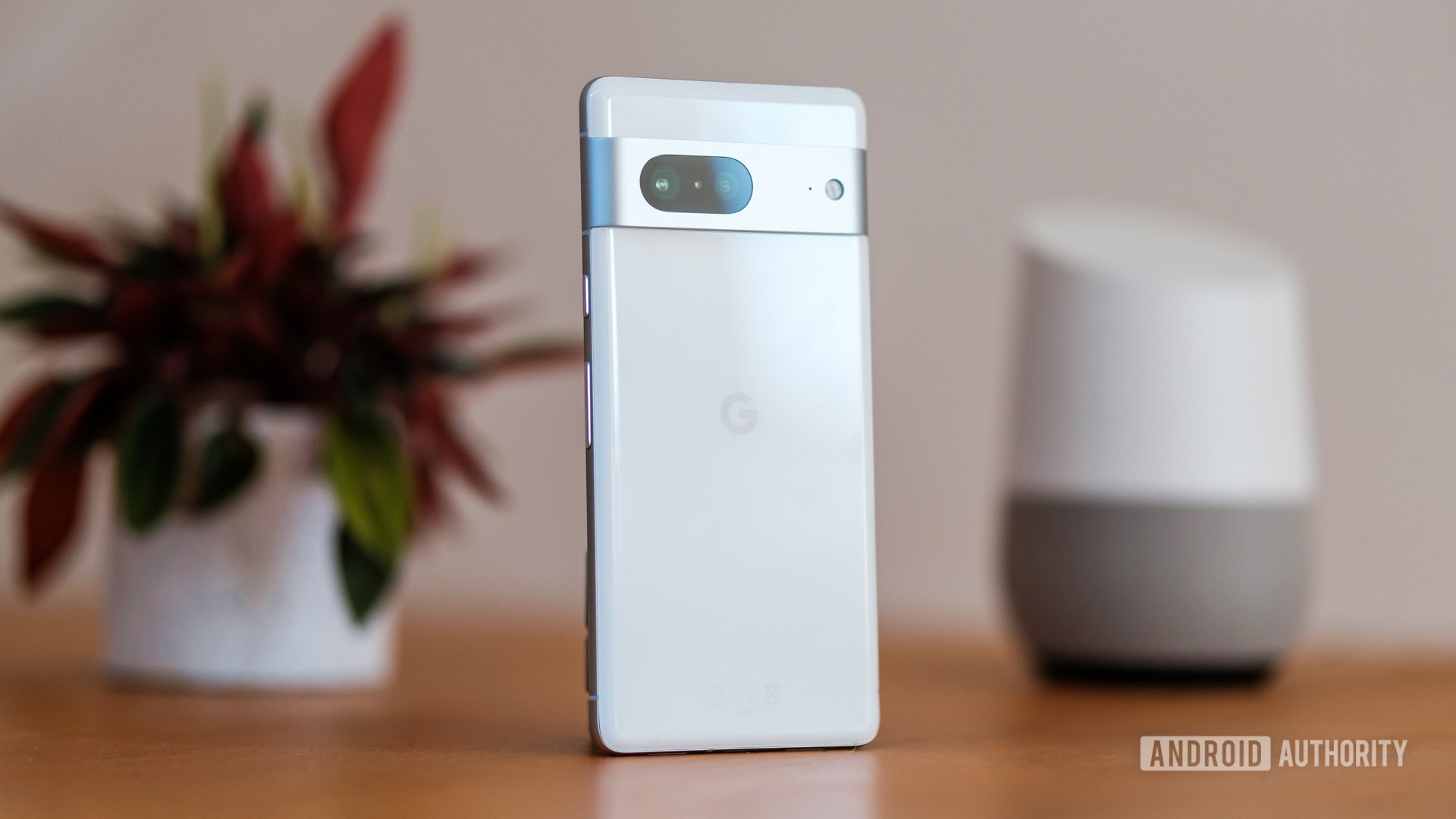
As is the theme throughout this review, the Pixel 7’s design builds on the Pixel 6 while being careful not to damage the precious foundations. Google has kept its predecessor’s unique camera bar, tinkering with the look to retain as much of its now-established brand identity as possible. The extruding black glass camera bar is replaced by a metal accent housing with distinct camera cutouts. The edges are a magnet for debris and dust, but such is the price for a design that’s distinctly different from the corner-positioned cameras on other flagship devices.
The brushed metal frame wraps neatly around to the side chassis, which adds a touch of polish. You’ll find sturdy and satisfying buttons on the right-hand side, accompanied by the familiar USB-C and speaker ports on the bottom of the handset. The entire package is protected by Corning Gorilla Glass Victus (an upgrade over the Pixel 6, which opted for Gorilla Glass 6 on the rear) and an IP68 rating for dust and water resistance. It’s built to last and certainly feels like it; a solid achievement at this price. That said, the glass back is a fingerprint and smudge magnet. Either slap a case on it or get used to carrying microfiber cloths around with you. Thankfully, this isn’t a factor with the Pixel 7’s successor.
The regular Pixel 7 has a flatter display than the Pro model, but that comes with chunkier bezels as a trade-off. Thankfully, the beautiful 6.32-inch OLED display remains usable in one hand, even without rounded corners. While smaller than the Pixel 6’s panel, the pixel density and screen-to-body ratio is higher. In fact, the device itself is smaller, thinner, and lighter than the Pixel 6. It’s not quite small enough to be considered compact like the Sony Xperia 5 V, and it’s taller than the iPhone 15, but it will fit in a pocket with a case on much more comfortably than larger flagship phones.
Personally, I preferred the Pixel 6’s design, at least aesthetically. There’s something a little odd about the Pixel 7’s understated yet futuristic design that doesn’t quite work together for me. Maybe the black camera housing, metal, and gloss combo is a bit much, like a pinstripe suit paired with a plaid tie. But I can see how others may prefer the curved and metallic look over the Pixel 6’s solid glass camera bar. Either way, I do miss the additional fun two-tone color options that really helped make the Pixel 6 your own. Nitpicking aside, there’s no denying that the rebuild feels robust in the hand and it’s a little bit better built overall. It’s a welcome refinement, even if it might not be to everyone’s taste.
The Pixel 7's redesign feels more robust in hand.
Move past the aesthetics, though, and you’ll find a few hidden improvements onboard. The Pixel 6’s dubious optical in-display fingerprint scanner has been fine-tuned and is now empirically more responsive than its predecessor. If you’re still unsure about this comparatively crude method of fingerprint scanning compared to high-end ultrasonic models, Google offers the option to use Face Unlock for the first time since the Pixel 4. Just be aware that, as it only uses basic imaging rather than 3D depth data, the Pixel 7’s Face Unlock feature can’t be used with banking apps or other secure biometric services. It’s simply there to quickly unlock your screen — something it does very well.
How does the camera hold up?
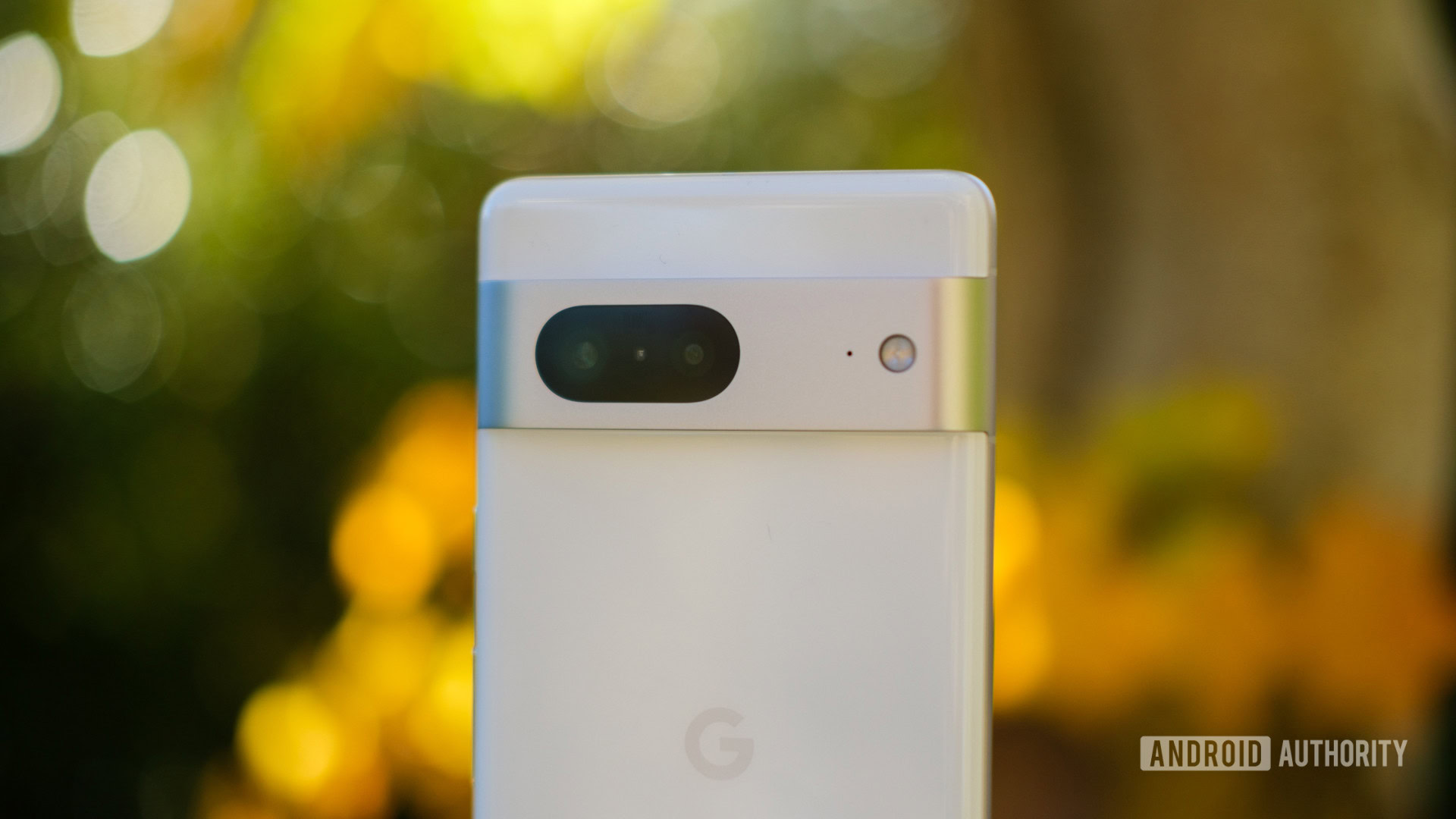
We’ve taken arguably far too many pictures with the Pixel 7 series across the Android Authority team, and we’re collectively convinced this is one of the best camera phones ever produced at this price. Whether it’s tough HDR lighting, shooting at night, or getting a bit more creative with Cinematic video, the Pixel 7 has you well covered. Broadly speaking, Google’s machine learning smarts continue to help its Pixel smartphones punch well above their price tag, making photography capabilities one of the chief reasons to pick up the Google Pixel 7. Just see for yourself in the gallery below or check out the full-res samples in this Google Drive folder.
Exposure, colors, and detail are all spot-on across a wide range of scenarios. That being said, the Pixel 7 misses out on the more flexible shooting features of its bigger sibling. It’s stuck with a fixed-focus ultrawide camera (so you don’t get the Pixel 7 Pro’s macro mode), and the phone lacks a telephoto lens for long-range optical zoom.
In fact, the rear camera hardware is entirely unchanged from the Pixel 6, only the selfie camera has been upgraded to match the Pro’s 10.8MP resolution. So while we can’t help but love what Google has done here, we also can’t ignore that some of the same old gripes persist. This includes a comparatively limited 114-degree ultrawide field of view and occasional focus issues. Meanwhile, zoom quality only holds up to about 3x, despite the inclusion of Google’s Super Res Zoom machine learning smarts. Though admittedly, the fact it can take usable 3x zoom shots at all with no dedicated hardware is impressive.
While we’re being picky, there are a few areas in which the already superb Pixel 7 cameras could still be better. Very low-light snaps, for instance, can be a little grainy and noisy, particularly in darker areas. Portrait skin textures are still too harsh, owing to the mode’s crop factor, while skin tones can be too warm, and bokeh edge detection still isn’t perfect either, especially when it comes to fine hairs and complex background separation. The selfie camera is a bit softer, which would usually be a complaint but actually helps even out the Pixel’s oversharpening, resulting in marginally better-looking portraits.
With the Palm Timer feature included with the June 2023 update, you can also hold your palm up to trigger a timer when shooting selfies. This makes the process a little more comfortable.
As for shooting modes, Action Pan and Long Exposure remain; they’re suitably fun to use but likely to be quickly forgotten about. Night Sight is 2x faster to capture images than last year, but the quality is pretty much the same. Overall, the photography feature experience isn’t meaningfully elevated from the admittedly already solid Pixel 6. Most of the fresh photography magic is reserved for after you’ve taken the shot, but we’ll get to that in the next section.
That said, the Pixel 7 has a new trick up its sleeve for shooting — Cinematic video. This adds the same artificial bokeh blur as Google’s Portrait mode to videos, though it’s limited to 24fps, a 1080p resolution, and can only be used with the main camera. At its best, the results are competitive with Apple’s Cinematic mode, but recent iPhones can shoot in 4K too and produce slightly sharper footage even at FHD. Both suffer from familiar software bokeh issues around hair edges, but Apple’s implementation is a lot better at ensuring consistent foreground and background separation. The Pixel wobbles in and out of focus far more regularly. If you’re more interested in standard videography, the Pixel 7 records 4K at 60fps from both lenses, can capture 10-bit HDR at 4K at 30fps, and offers rock-solid digital video stabilization.
The Pixel 7 is a functional rather than creative photography powerhouse, but it's a powerhouse nevertheless.
Overall we’re sufficiently impressed with the Pixel 7’s photo and video capture features, but it isn’t without some compromises. Sadly, you can’t have it all on a budget. Google’s basic package lacks the fun of the Samsung Galaxy A53 5G with a dedicated macro lens or the telephoto credentials of the marginally pricier Galaxy S21 FE, though it trounces both as a point-and-shoot camera phone. Its dual cameras are also a similar setup to the more expensive iPhone 14, so Google’s affordable option is competitive in that regard, too. It’s also a step ahead of the budget Pixel 6a due to the superior main sensor.
Unlike its bigger sibling, the Pixel 7 is more of a functional rather than creative photography powerhouse, but it’s a powerhouse nevertheless, and without doubt the best value camera phone you can get.
Since this review was first published, Google rolled out a few changes to the Pixel Camera app in October 2023. For one, it’s now easier to jump between video and stills capture. Each section also offers quick access to other features and capture modes, like Night Sight and Cinematic. We never had any issue with the original camera app, but the improvements are welcome.
In March 2024, Google brought 10-bit HDR video and Ultra HDR support to Instagram, allowing users to capture more detailed images directly from the social media app.
Is Google’s software really that good?
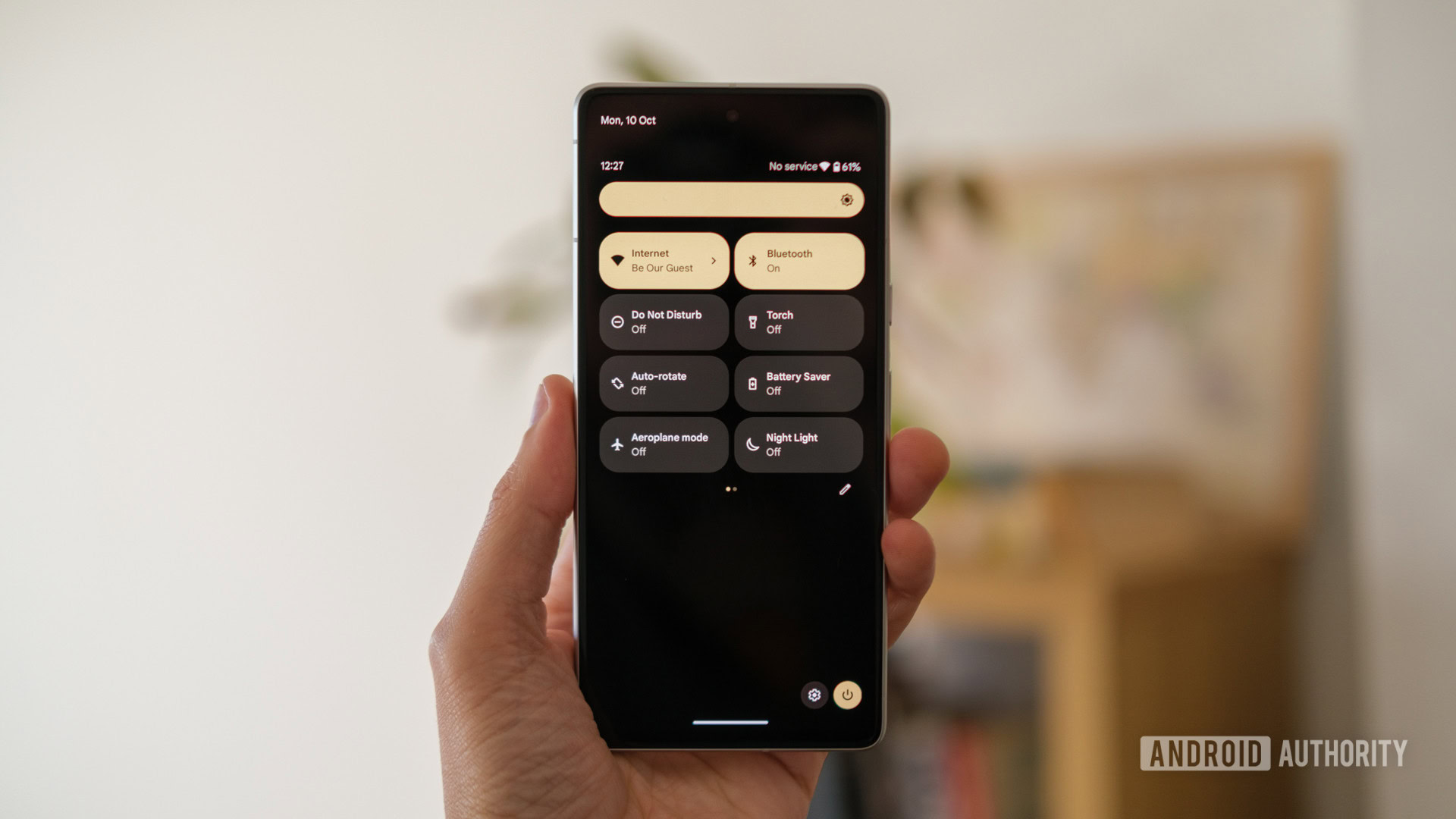
After photography, Google’s “default” take on Android is another stand-out reason to get your hands on the Pixel 7. With fully-fledged Material You theming and a smattering of Pixel-only features, series fans feel this is the definitive version of Android. It’s hard to disagree.
The ins and outs of Android are well documented, and the core experience feels very familiar. So let’s step back to look at the big picture. After years of disjointed services, Google is finally leveraging its broader ecosystem for its handsets, creating a cohesive experience for Pixel owners that’s arguably a cut above what you’ll find elsewhere in the Android ecosystem.
For instance, Photo Unblur, Magic Eraser, and Portrait Light — a simple editing tool used to alter the lighting around faces — combine to make the Pixel 7’s version of the Google Photos app an even more powerful platform for editing pictures, old and new. Machine-learning-enhanced Recorder and voicemail message transcriptions are handy, even if not likely to be universally useful features, while offline Google Assistant typing for GBoard returns and is snappier than ever thanks to the Tensor G2. Google’s AI smarts certainly help give the phone a unique and useful edge.
Emergency features received further tuning with the June 2023 feature drop. Users can now ask Assistant to start sharing emergency details or schedule periodic safety checks. Car Crash Detection can now include real-time location data alongside call status with contacts.
Google's AI smarts gives the Pixel 7 a unique and useful edge.
Meanwhile, freebies like three months of 100GB Google One storage and YouTube Premium give you a bit more out of Google’s existing services just for being a Pixel customer. Of course, Google would love you to pay for these long-term too, but the point is that there’s a Google service within easy reach for virtually every need you might have, from work to play.
Some of the Pixel 7’s most exciting software features weren’t available at launch, but we’ve since seen them arrive as part of Google’s famed feature drops. New — or rather late — additions include Google’s Clear Calling and the free VPN by Google One. The VPN is pretty self-explanatory and a great way to save money, but you might get more day-to-day use from Clear Calling. It works to reduce background noise and enhance the speaker’s voice, giving you clearer audio in loud environments.
Another new tweak for the Pixel 7 is that the Recorder app can transcribe recordings of multiple speakers and automatically label them. It also adds line breaks when the speaker changes and includes speaker labels to improve Google Docs transcript searches, just to make life a little easier. We’re still waiting on Spatial Audio, which will add head tracking to your Pixel Buds Pro for deeper immersion in shows, movies, and music.
Google’s feature drops also add new wallpapers to celebrate different cultures and holidays, while the June 2023 update now lets you create your own wallpapers using Emoji Kitchen. It’s a great feature and really adds a splash of personality to the device.
In October 2023, Google brought Android 14 and that month’s Pixel Feature Drop to the Pixel 7. It added new monochromatic themes, custom clock and wallpaper collections and editing, charging accessory notifications, and app streaming if you use a Chromebook. In December, Google added several camera features, including Photo Unblur support for animals and Portrait Light mode, and more practical features, like Repair Mode and Call Screen improvements.
The phone gained more AI-orientated features in the March 2024 Pixel Feature Drop. Circle to Search, which first appeared on the Samsung Galaxy S24 series, funneled down to the Pixel 7 duo, allowing users to search for items that appear on display. A new “Hello?” feature for Call Screen also ensures you don’t waste time talking to unresponsive callers. Other additions include App screen sharing and Fast Pair improvements.
Overall, the Pixel 7’s software is clean, intuitive, and useful — just what you want from a modern phone.
How powerful is the Tensor G2 chip?
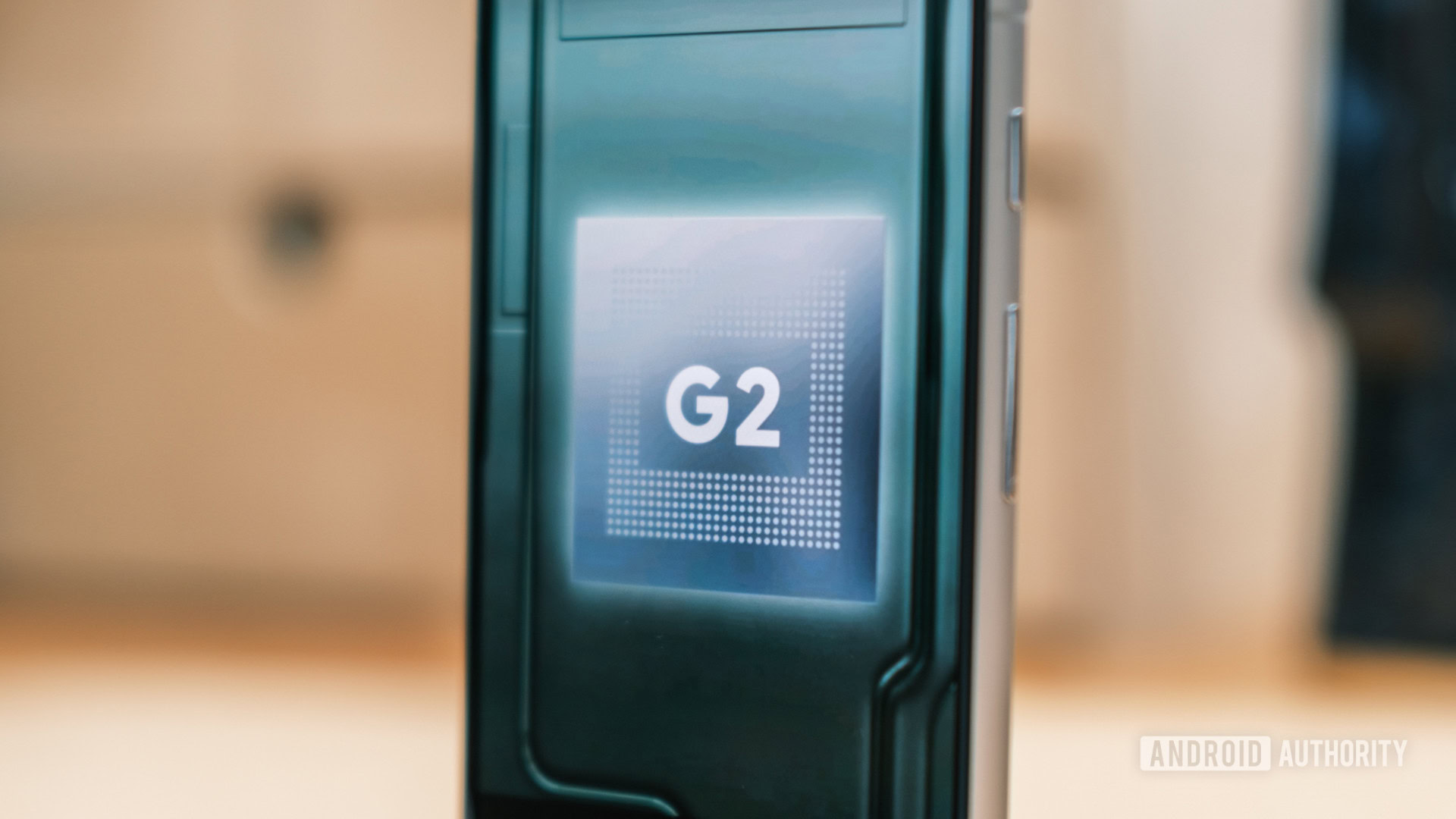
Another what’s old is new again feature is Google’s Tensor G2 chipset. Sporting a very similar CPU arrangement to the first Tensor, day-to-day performance is still snappy enough for all your regular apps. Multitasking is a breeze, particularly when paired with the display’s 90Hz default mode. However, just like with the first generation, this isn’t a benchmark topping chip, which might leave performance enthusiasts a little underwhelmed.
Colleagues at Android Authority noticed the Tensor G2 can become a little warm when flipping through multiple apps or even watching videos for extended periods. However, I haven’t noticed the same propensity for heating up any more than any other phone I’ve used recently (though it was cooler in the UK during this review). Most importantly, any heat buildup doesn’t seem to have a severe impact on performance.
With that in mind, gaming definitely causes the phone to perspire. The chip’s Mali-G710 MP7 GPU, although it’s newer, doesn’t provide an additional performance boost over the original Tensor chip’s graphics core, so it sits well down the graphics benchmarking pecking order. That said, we have noticed much improved sustained performance with the new graphics processor. Under extreme stress, the Tensor G2 makes up for its lack of peak performance and closes the gap between many Snapdragon 8 Gen 1 handsets. That bodes well for using the phone for protracted, intensive sessions on hotter days.
Benchmarks are one thing, but what about real-world gaming use? I logged a rock solid 60fps playing over an hour of Apex Legends and Call of Duty: Mobile with the graphics settings cranked up. The Tensor G2 certainly isn’t short on power for some of the more popular titles out there. The bigger uncertainty is how this chip will handle more demanding games a couple of years down the line, with the comparative lack of raw power suggesting it won’t keep up as well as today’s rival flagship chipsets. But then again, that’s not such a concern with a $599 price tag, and the Tensor G2 hums along just nicely for a mid-range processor — one that, lest we forget, is also pushing the boundaries of machine learning capabilities on smartphones.
Tensor G2 is not the fastest chip, but its machine-learning smarts power unique experiences.
With heat listed as a minor issue and a smaller battery onboard compared to the Pixel 6, you might be concerned about a knock-on for battery life. Thankfully there’s no such correlation. The Pixel 7 survived a day of heavy gaming, web browsing, and video watching and still made it to bed with 15% to spare. With lighter workloads, predominantly checking email and listening to music, I could comfortably make it through the day with half the moderately sized 4,355mAh battery to spare. Depending on your needs, you’re likely to see between a day or two’s worth of screen-on-time. This is good news because wired charging is painfully slow, even with a compatible USB Power Delivery PPS wall plug. The 21W charging takes a painstaking one hour and 41 minutes to full. You can hit 50% in 30 minutes, but that won’t be enough juice to take you through a full day with meaningful headroom.
That said, there are instances where you’ll see the phone chug down the battery more quickly, and it’s mostly when using the camera. Recording a 15-minute Cinematic video took 7% off the battery and heavy camera sessions using portrait, night sight, and other AI-infused modes chugged down a fair bit of juice. The brighter display certainly helps out in outdoor viewing, but can also take a bit of a chunk of your daily usage metric if cranked up for a long period of time. Overall though, the Pixel 7’s battery life is robust enough, but the charging power cap does let it down a bit.
Anything else?
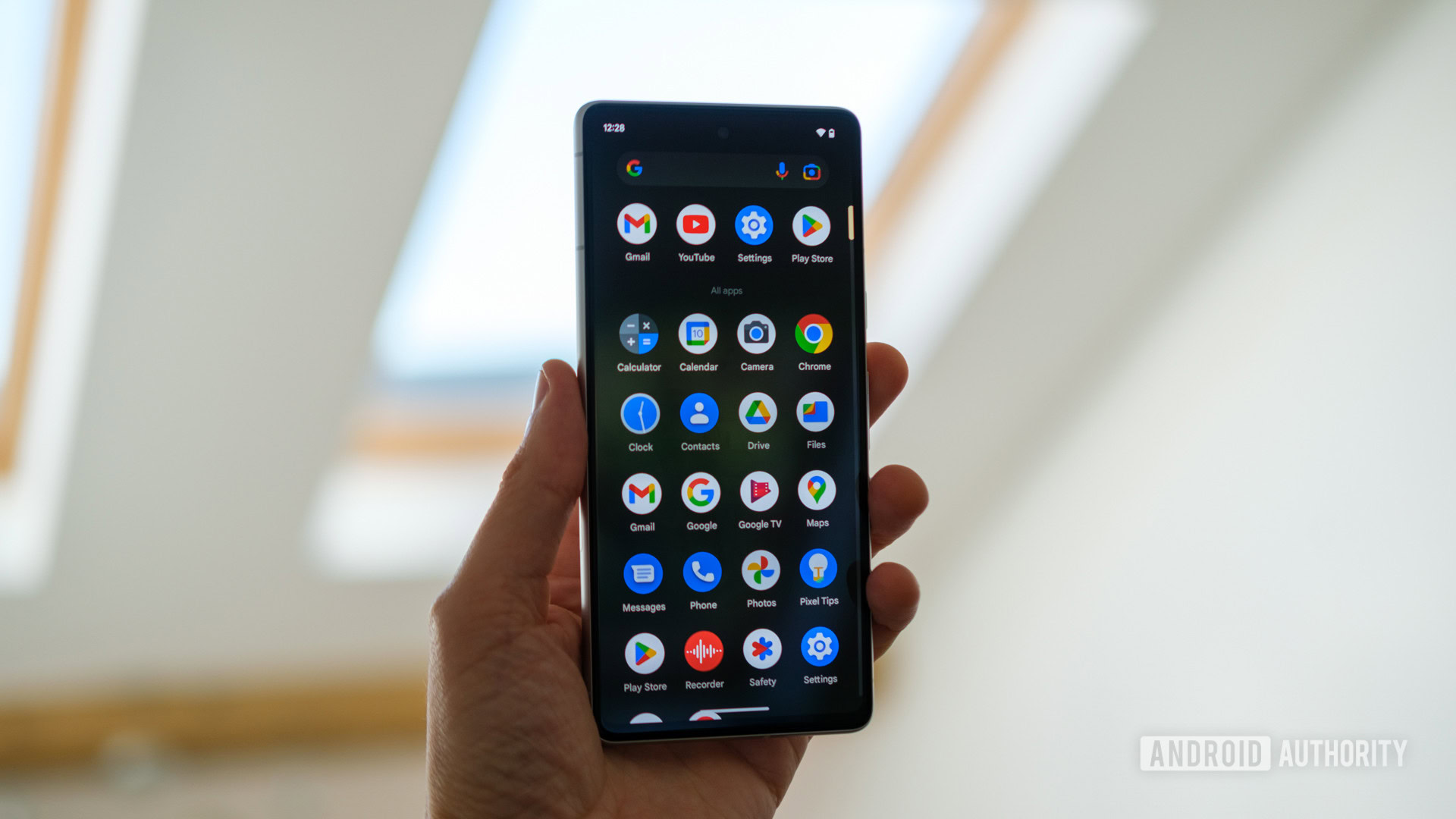
- Bluetooth audio: With no headphone jack, you’ll be reliant on the Pixel 7’s support for SBC, AAC, aptX, aptX HD, and LDAC Bluetooth audio codecs. There’s an LE Audio toggle in the Pixel 7’s developer settings, but we were unable to confirm if this is functional due to a lack of supported headphones.
- Connectivity: Bluetooth 5.2, NFC, and Wi-Fi 6E round out a robust connectivity suite that will have you well covered for fast wireless data transfers and other connectivity needs. There’s no ultra-wideband (UWB) support here —that’s exclusive to the Pro model. Speaking of connectivity, the Pixel 7 seemingly addresses a major issue we saw with the Pixel 6, providing a much more robust data connection in congested locations.
- Display: The panel’s color is excellent, and the resolution is sharp enough, making your snaps and HDR moves look sublime. The display’s 90Hz mode is plenty smooth even next to 120Hz rivals, but I only clocked it lowering the refresh rate to 60Hz. It’s not as battery-friendly as some of the ultra-low refresh LTPO panels we’ve seen.
- Speakers: These speakers are plenty loud but aren’t as impressive as the Pixel 7 Pro’s setup. They’re upper-mid-heavy and lacking bass, producing a tinny quality on heavier tracks. Stereo separation isn’t brilliant, as the top speaker is hidden behind the display, but it’s fine enough to hear most of what’s going on in the mix.
- Updates: Google promises a not-quite industry-leading three OS upgrades and five years of security patches for the Pixel 7. With Android 13 shipping out of the box, this means the phone will see core feature updates into 2025, followed by security patches for a further two years. Currently, only Samsung offers a better policy across multiple phones with its four years of OS upgrades. Notably, the Pixel 8 series will receive seven years of updates and seven OS upgrades. The Pixel 7 will not.
- 5G: US models from the Google Store, AT&T, and Verizon support mmWave and sub-6GHz 5G networks. Other regions, such as the UK and the rest of Europe, only support sub-6GHz bands. All regions sport a single-nano SIM and an eSIM.
Google Pixel 7 specs
| Pixel 7 | |
|---|---|
Display | 6.32 inch 2,400 x 1,080 pixels 1,400 nits 90Hz OLED |
Processor | Tensor G2 |
RAM | 8GB |
Storage | 128/256GB |
Power | 4,355mAh Li-Ion Wireless charging Up to 72 hours of runtime with Extreme Battery Saver |
Cameras | Rear - 50MP main 1.2 μm, ƒ/1.85, 82-degree FoV 1/1.31-inch sensor OIS and EIS - 12MP ultrawide 1.25 μm, ƒ/2.2, 114-degree FoV - Laser AF Front: - 10.8 MP 1.22 μm, ƒ/2.2, 92.8-degree FoV |
Connectivity | 2G, 3G, 4G, 5G Bluetooth 5.2 NFC Wi-Fi 802.11ax |
Dimensions | 155.64 x 73.16 x 8.7mm |
Software | Android 13 |
Durability | IP68 |
Value and competition


Despite its budget-friendly $599 price tag, the Pixel 7 is every bit a competitor to the more expensive Apple iPhone 15 ($829.99 at Amazon) and Samsung Galaxy S24 ($859.99 at Amazon). With image quality, video features, and a robust build that rival entry-level flagships from Apple and Samsung, the Pixel 7 series is an absolute steal by comparison. While these rivals have their own merits, they’re tougher sells due to their higher price tags.
There are similarly priced buys out there worthy of your consideration, too, of course. Samsung’s Galaxy A54 5G ($379.5 at Amazon) is more affordable, offers long-term support, and has a 120Hz display and triple camera setup. However, it doesn’t offer the 4K/60fps video capabilities, high-tier performance, or main camera consistency you’ll get from the Pixel 7.
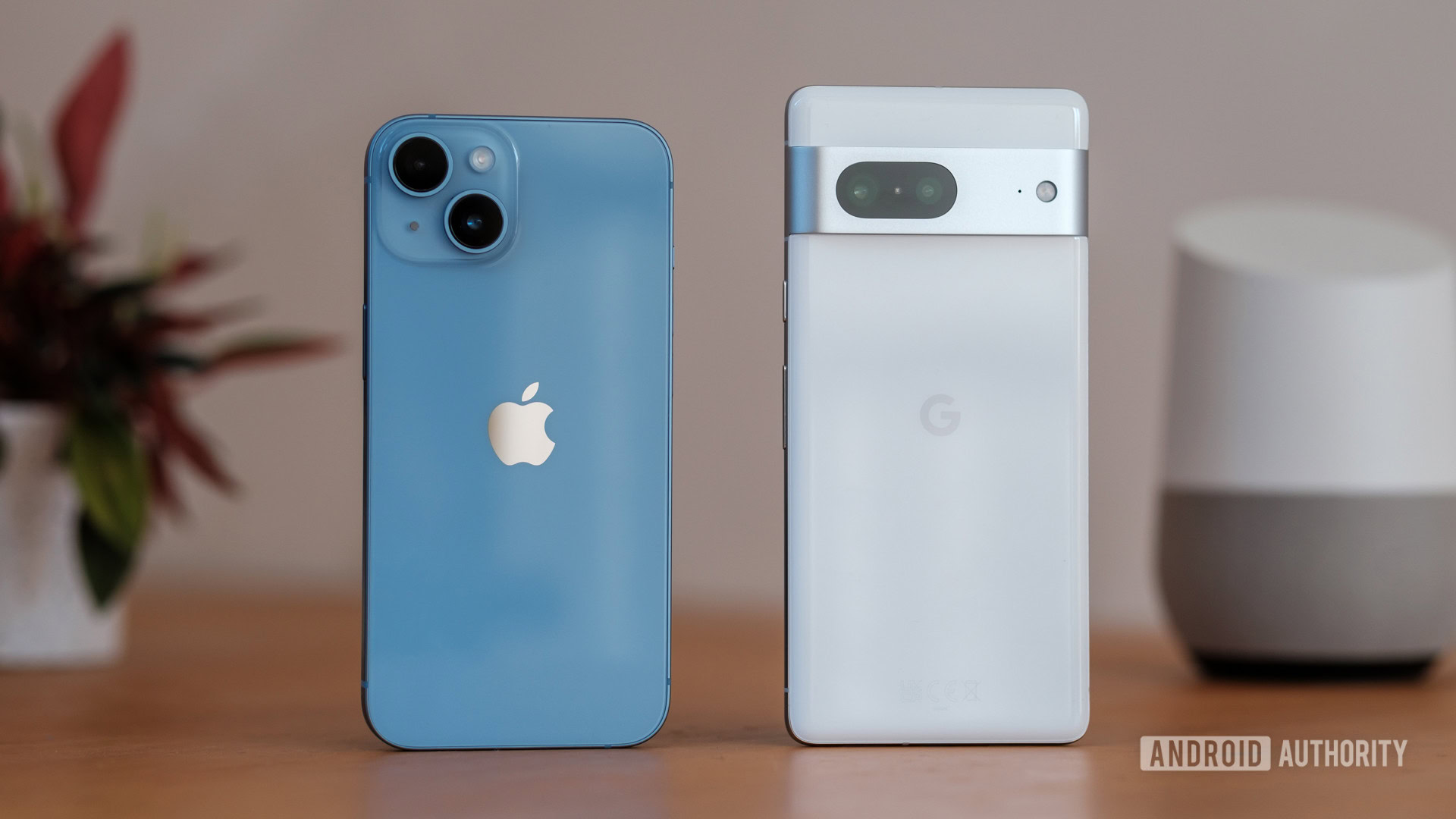
If you’re happy to spend on the other side of the Pixel 7’s price tag, the Samsung Galaxy S23 FE ($699.99 at Amazon) nets you a more powerful chipset, versatile camera setup, and a variety of colorways. Although it’s newer, it costs the same as the Pixel 7, though it’s fairly dull in terms of design and, again, can’t match the Pixel 7’s primary shooter for photography.
It's very difficult, if not impossible, to beat the Pixel 7's value proposition.
Seeking a left-field option? The OnePlus 12 ($899.99 at Amazon) beats Google at the numbers game, packing a faster chipset, much more RAM, and a massive QHD+ display. It also offers faster wired and wireless charging. It is pricier, though, but that where the slightly pared-down OnePlus 12R ($599.99 at Amazon) might appeal.
Perhaps the best alternative options come from Google itself. We’ve discussed the differences between the Pixel 7 Pro ($589.98 at Amazon) and Pixel 7 at length, and while the former — itself a relative bargain compared to $1,000+ flagships — gets the best upgrades for Google’s seventh-generation phones, $300 is a lot of money to save. The Pixel 7a ($477 at Amazon) gives budget-strapped buyers an alternative in the Google family, and fixes plenty of issues present with the Pixel 6a ($314 at Amazon). However, the Pixel 7a is just $100 shy of the Pixel 7, which makes the latter device look like an even better bargain.
Then there’s the Pixel 8 series. The Pixel 8 ($699 at Amazon) improves on almost every aspect of the Pixel 7. A new chipset, brighter display, more refined design, and upgraded cameras should make for a more complete smartphone for just $100 more.
Ultimately, at the right price, it’s very difficult, if not impossible, to beat the Pixel 7’s value proposition.
Google Pixel 7 review: The verdict
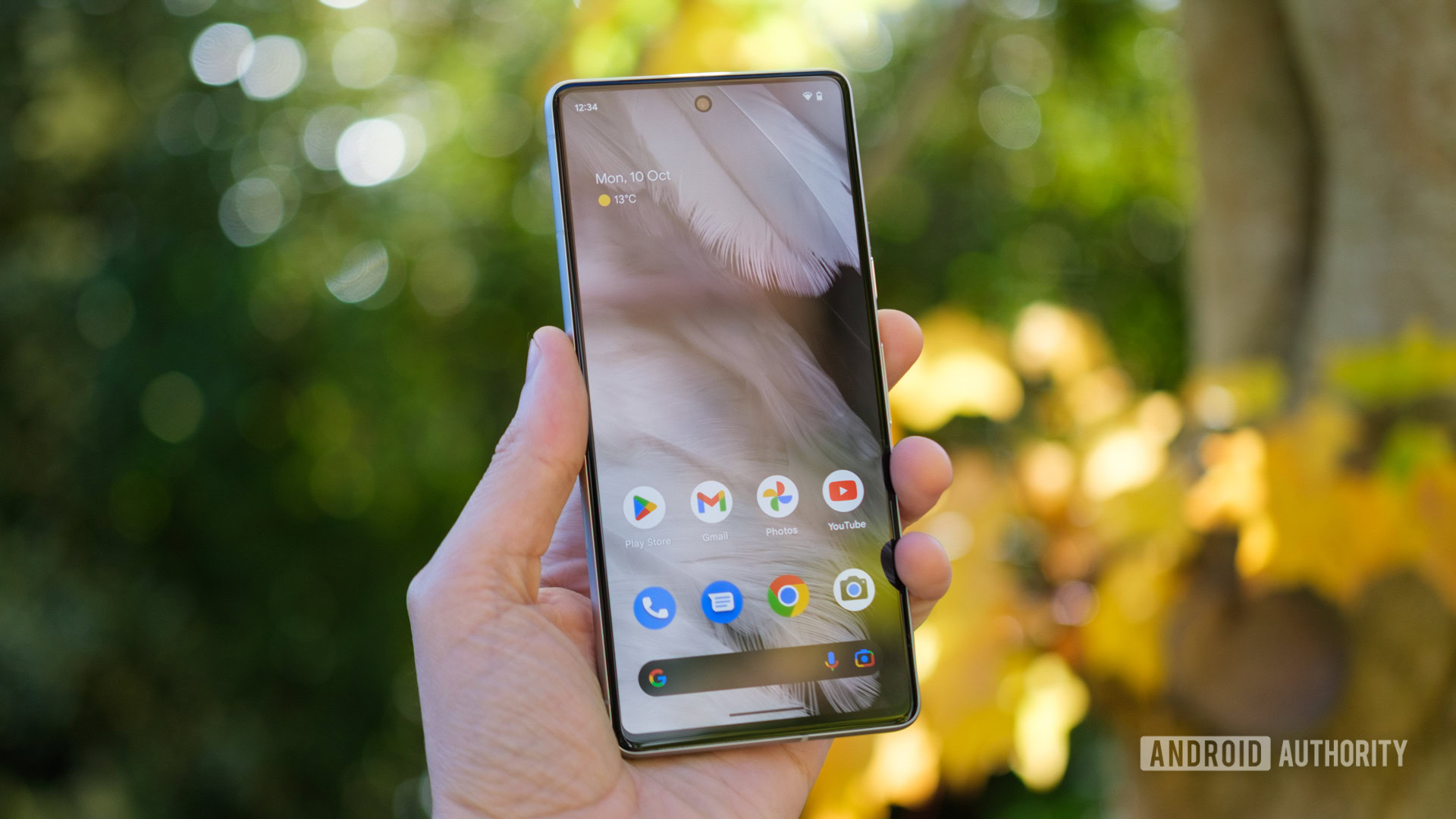
The Pixel 7 is a home run for Mountain View. With long-term software support, an expansive app and feature ecosystem, and solid performance, the Pixel 7 covers all the bases and then some for a price that’s lower than the competition. Furthermore, the camera package is excellent, on balance, and remains one of the leading reasons to dive into Google’s handset. But if that’s not enough, the prospect of future feature drops hints that the phone will only become better over time, just like the Pixel 6.
The only real criticism we can level is that the handset isn’t a meaningful improvement over the previous generation. Google has, thankfully, kept its price stagnant to reflect this. Although the addition of Tensor G2, stronger rear glass, a retooled fingerprint scanner, and a new selfie snapper are nice to have (not to mention the improved data reception), they’re not a reason to upgrade. The slow charging times and so-so speakers also take some polish off the handset, highlighting that Google had to retain some compromises to keep the price down.
Google's Pixel 7 covers all the bases and then some, all while costing a lot less than the competition.
By comparison, the Pixel 7 Pro has seen a few more noteworthy upgrades than its little sibling, including a 5x periscope camera and a wider ultrawide camera that finally has autofocus. It also continues to boast a brighter 120Hz QHD display, marginally faster charging, and a notably bigger battery. Google has seemingly paid less attention to improving the regular Pixel 7 formula. Even so, these are all worthwhile compromises to save a considerable $300 over Google’s premium flagship.
Although those really into their photography will no doubt be (rightly) tempted by the Pro model, there’s a lot of phone to love with the Pixel 7, and it comes at a price that’s virtually impossible to regret. That makes the Pixel 7 incredibly easy to recommend, whether you’re looking for a phone to take you through a busy work day, handle gaming sessions on your commute, or snap great-looking pictures of your loved ones. Google’s affordable flagship can do it all.
Top Google Pixel 7 questions and answers
The Google Pixel 7 offers an IP68 rating for water and dust resistance. It can be submerged in a meter and a half of water for up to 30 minutes, though it is not truly waterproof.
Yes, the Pixel 7 has one nano-SIM tray and eSIM support.
Yes, the Pixel 7 supports Google’s Face Unlock feature. However, it is not secure enough for banking or purchasing transactions, only for unlocking your device.
No, Google’s Pixel 7 does not include a charger.
In the US, the Pixel 7 supports both mmWave and sub-6GHz networks. European models only support sub-6GHz speeds.
No, the Pixel 7 does not have an SD card or microSD slot. If you need more than the onboard storage, you’ll have to rely on cloud storage.
The Pixel 7 is available in Obsidian (black), Snow (white), and Lemongrass (yellow) colorways.
Yes, the Pixel 7 can charge wirelessly at up to 21W with a Pixel Stand or 12W with other chargers.